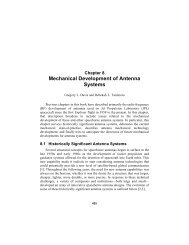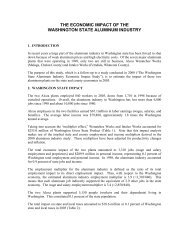WORLD POPULATION TO 2300
WORLD POPULATION TO 2300
WORLD POPULATION TO 2300
You also want an ePaper? Increase the reach of your titles
YUMPU automatically turns print PDFs into web optimized ePapers that Google loves.
5<br />
4<br />
3<br />
2<br />
1<br />
0<br />
Figure 8. Average annual rate of change of the world population and<br />
total fertility, estimates and three scenarios: 1950-<strong>2300</strong><br />
-1<br />
1950 2000 2050 2100 2150 2200 2250 <strong>2300</strong><br />
Forty years later, world population growth reaches<br />
its low point of -0.15 per cent. Population growth<br />
takes somewhat longer after fertility bottoms out<br />
to reach its minimum in the high and low scenarios,<br />
but the sequence is similar.<br />
A comparison with the previous long-range projection<br />
indicates the importance of fertility assumptions.<br />
That projection was based on the 1998<br />
Revision and took population up to 2150. World<br />
population growth up to 2050 in the 2002 Revision<br />
is strikingly similar to growth in the 1998<br />
Revision, as noted earlier. However, the longrange<br />
projections beyond 2050 are quite different,<br />
with that based on the 1998 Revision showing<br />
steady growth (figure 9). The reason is fairly<br />
straightforward: fertility was assumed, in the earlier<br />
long-range projections, to stay only briefly<br />
below replacement, returning essentially to replacement<br />
a decade beyond 2050 rather than, as in<br />
the current projection, staying clearly below for a<br />
century after 2050. Many countries in developing<br />
regions, in the earlier projection, never fall below<br />
replacement fertility, but in the current projection<br />
they do. The assumption, therefore, that fertility<br />
will fall to low levels for a fairly long period, not<br />
just in more developed but also in less developed<br />
regions, is a distinctive characteristic of the current<br />
long-range projections.<br />
Mortality levels play a role in long-range population<br />
growth, helping account for the temporary<br />
decline and being responsible for change once<br />
fertility has settled at replacement. The role of<br />
mortality, however, is not evident from trends in<br />
life expectancy. World life expectancy is projected<br />
to grow along a smooth path but at a slowing<br />
pace. It is expected to reach 74.8 years in<br />
2050—after having risen about 20 years in 1950-<br />
2000 and rising further about 10 years in 2000-<br />
2050. Gains beyond 2050 diminish: for 2050-<br />
2100, 8 years, and then for subsequent 50-year<br />
periods 5, 4, 3, and finally 2 years for 2250-<strong>2300</strong>.<br />
By the time rising life expectancy becomes the<br />
dominant and indeed the sole influence on<br />
growth—in 2225—it will be at 92.8 years and<br />
rising slowly, leading to an annual population<br />
growth rate over the next half century of only<br />
0.06 per cent.<br />
There is no indication from these trends that<br />
mortality change could produce fluctuations in<br />
United Nations Department of Economic and Social Affairs/Population Division 15<br />
World Population to <strong>2300</strong><br />
High<br />
Medium<br />
Low<br />
Total fertility<br />
Population growth rate (percent)





